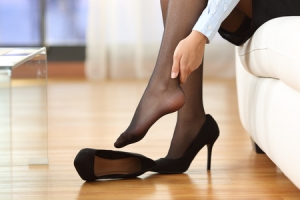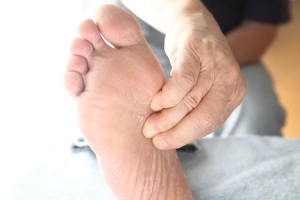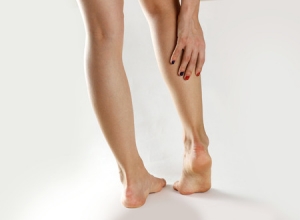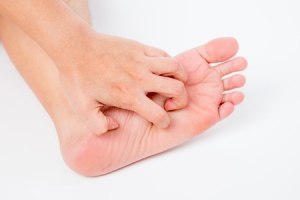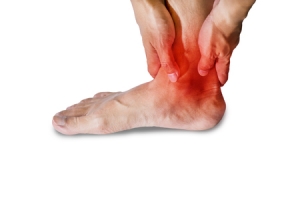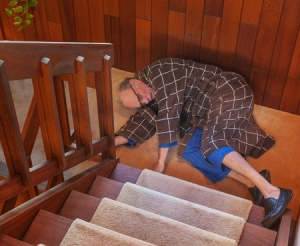Connect With Us
Blogs
Focus on Diabetic Foot Care
At Superior Foot & Ankle Care Center we treat many patients with diabetes. November is American Diabetes Month and a good opportunity for us to go over some care tactics for patients with this disease. Below are some key areas to focus on:
Your Daily Care Routine
Of course, a good foot care regimen is important for everyone, but for a diabetic patient, it is even more critical. Your daily care plan should include:
- Washing your feet with warm water and a mild soap
- Drying your feet completely, with extra care to ensure that the area between your toes is completely dry (this will help prevent fungal infections)
- Checking toenails for jagged edges. Always trim nails straight across with no rounded edges. Do not cut too short and never cut the corners.
- Inspect your feet from every angle. Look for changes in skin and nail color, rashes, flaking skin, bruises, swelling, any scratches or cuts. Report anything that concerns you to our podiatrists, Dr. Victoria Foley and Dr. Constance Omelas to evaluate. It’s always better to be over cautious!
Your Shoes and Socks
Shoes should have wide, roomy toe boxes and be made of soft, flexible materials. Avoid heels higher than 2 inches. When buying new shoes, have your foot professionally measured. Run your hand around the inside of the shoe to make sure there are no rough spots or loose stitching. Wear new shoes for only a few hours at a time and examine your feet after wearing to make sure there are no red spots or blisters forming.
Socks should be the type that wick moisture away from your feet. If you sweat excessively, change your socks multiple times throughout the day. Avoid socks that have overly tight elastic on the tops and those with seams across the toes.
Your Lifestyle Choices
Eating an appropriate diet to help manage your blood sugar is essential. A regular exercise routine will help you maintain a good weight and also improve circulation. Don’t smoke because it has a negative impact on circulation. Follow all of your doctor’s recommendations for keeping your diabetes under control.
If you have questions or concerns about diabetes and your feet, contact our Long Beach office today by calling: (562) 420-9800.
Facts about Haglund’s Deformity
Are you familiar with the condition known as Haglund’s Deformity? At Superior Foot & Ankle Care Center we find that patients have some misconceptions about this disorder which affects the heel. Below are some facts to better familiarize you with this foot problem:
FACT: Haglund’s Deformity is a bony enlargement that develops on the back of your heel. Other signs of this condition are swelling and redness around the enlargement and pain where the Achilles tendon attaches to your heel bone.
FACT: Another name for Haglund’s Deformity is “pump bump.” That’s because pumps with their stiff backs hit the bony enlargement and irritate it, resulting in pain when walking and wearing shoes.
FACT: More women than men get Haglund’s Deformity.
FACT: Although pumps aggravate the bony enlargement, they are not the cause of Haglund’s Deformity. This condition is the result of structural defects, including overly high arches, the tendency to walk on the outside of your heel or a tight Achilles tendon.
FACT: Haglund’s Deformity can only be corrected by surgery. There are, however, a number of conservative measures that can be used to relieve pain and decrease pressure on the bony protrusion. After our podiatrists, Dr. Victoria Foley and Dr. Constance Omelas, examine your heel and order x-rays or other imaging studies to confirm a diagnosis of Haglund’s Deformity a treatment plan can be determined.
FACT: Treatment for pump bump will depend in part on the cause. Heel pads, for example, may be recommended if the cause is high arches or stretching exercises for your calf if the source of the condition is a tight Achilles tendon. Custom orthotics can also be used to correct abnormal foot motion.
FACT: Pain from pump bump can be reduced by icing the bony enlargement. Apply an ice pack wrapped in a thin towel (do not apply ice directly to the skin) for 20 minutes at a time with a 40-minute break in between.
FACT: You can help prevent inflammation of the bony growth by wearing shoes with open backs or those made of soft materials. You should also avoid running on hard surfaces and up hills.
If you have additional concerns about Haglund’s Deformity, contact our Long Beach office by calling: (562) 420-9800.
Could You Have Metatarsalgia?
Are you experiencing acute pain in the ball of your foot? Is the pain more noticeable with increased activity or when you are walking barefoot? Have you noticed a callus beginning to form in the spot where the pain is? If you answered yes to one or more of these questions, you may be suffering from a condition we treat at Superior Foot & Ankle Care Center known as metatarsalgia.
Your metatarsal bones run down the middle of your foot from your ankle to each of your 5 toes. When the nerves between two of the metatarsals become inflamed, it causes pain, and this is known as metatarsalgia.
What’s Behind the Pain
Basically, metatarsalgia occurs when there is either too much pressure or an uneven pressure applied to the metatarsals. This can have a wide range of causes, however, including:
- Overpronation
- Arthritis
- Foot injuries
- Aging
- Weight gain
- Overuse from weight-bearing sports such as running
- Foot deformities
- Morton’s neuroma
- Poorly fitting footwear
- Standing for long periods on hard surfaces
Getting Relief
The treatment for metatarsalgia will depend on the cause. The first step is to have our podiatrists, Dr. Victoria Foley and Dr. Constance Omelas examine your feet. The foot doctor will also want to get your medical history and ask about your recent activities. Once the reason behind the metatarsalgia has been found, the foot doctor may recommend one or more of the following:
- Icing the area and taking over-the-counter anti-inflammatory medications to relieve pain and inflammation
- Resting your feet from sports and physical activities that aggravate the ball of the foot
- Custom orthotics to correct overpronation or other biomechanical issues
- Wearing properly fitting, supportive shoes
- Losing weight if you are overweight to reduce pressure on your feet
If you are experiencing pain or pressure in the ball of your foot, contact our Long Beach office today for an appointment by calling: (562) 420-9800.
Don’t Be Frightened of Scary Sounding Foot Disorders
It’s the time of year for fright fests, haunted houses and all kinds of scary attractions, but at Superior Foot & Ankle Care Center we believe the podiatrist’s office shouldn’t be one of them! Many times, patients may get a diagnosis that sounds scary. In most cases, however, the name of a disorder may sound more frightening than it is. The job of our podiatrists, Dr. Victoria Foley and Dr. Constance Omelas is to make sure you understand a diagnosis and the treatment recommended for it. Your job as a patient is to ask questions until you feel confident that you comprehend your condition and treatment plan. Below are a few foot problems that illustrate our point.
Xerosis: while this may sound like a condition common to an ancient Greek god, it’s actually a term to describe very dry skin. Dry air, showering too frequently with very hot water or the soap you are using may all be the underlying cause. In some cases, dry skin can be a symptom of a systemic disorder. Usually, however, applying a super-rich moisturizer to your feet several times a day will eliminate xerosis.
Ganglions: you may be a little frightened when you start to experience numbness, tingling and pain in your feet for no apparent reason. Oftentimes, however, these symptoms are caused by small fluid-filled sacs that occur in the tendons or joints on the top of the feet or ankles. Repetitive stress to tendon linings and joints and shoes that constrict your feet are frequently the reason behind ganglions.
Brachymetatarsia: no, it’s not a pre-historic dinosaur. This term describes a defect in the growth of a toe bone that results in one of the metatarsals being shorter than the rest of the toe bones. It will commonly be seen in both feet. In some cases, this condition will not cause pain or discomfort, but it can affect balance so careful shoe selection will be necessary. For other patients, surgical remediation may be necessary.
Don’t hesitate seeking evaluation of foot or ankle symptoms. Putting off treatment is when foot conditions can truly become scary. Contact our Long Beach office today for an appointment by calling: (562) 420-9800.
4 Ways to Prevent Achilles Tendonitis
At Superior Foot & Ankle Care Center a condition that we frequently see in both experienced athlete’s and “weekend warriors” is Achilles tendonitis. The Achilles tendon, also known as the heel cord, is a band of tissue that runs down the back of your lower leg, connecting your calf muscle to your heel bone. Although it is the strongest tendon in the body, it is also one of the most frequently injured. Inflammation of the Achilles tendon, known as Achilles tendonitis is an overuse injury which is caused by putting too much stress on the tendon too abruptly. If left untreated, the ongoing stress to the tendon prevents the body from repairing the injured tissue and the result is a continued pain. Below are some strategies for avoiding this common podiatric disorder:
- Slow and steady wins the race. And, it helps prevent Achilles tendonitis, too. If you have been inactive for a period of time and wish to resume or start a new exercise program, begin slowly. Gradually increase the length and intensity of your activity.
- Don’t choose pain before gain. Even experienced athletes can experience Achilles distress if they decide to significantly increase the difficulty of their workout. Running hills and stair climbing puts particular strain on the Achilles tendon and should not be suddenly increased.
- Stretch it out. One of the best ways for anyone to head off an Achilles tendon problem is by stretching. Exercises that specifically help to stretch and strengthen your calf muscles will help avoid tendonitis.
- Get some support. Patients with flat feet have a higher risk for Achilles tendonitis because as the arch flattens it increases the strain on the Achilles tendon and calf muscles. Be sure the shoes you wear (both on and off the field) have adequate arch support. Our podiatrists, Dr. Victoria Foley, and Dr. Constance Omelas may suggest a custom orthotic device to wear in your shoes for added support.
If you are experiencing soreness, aching or stiffness anywhere along your Achilles tendon, contact our Long Beach office (562-420-9800) to get it evaluated.
Eat This Not That for Less Joint Pain
World Arthritis Day takes place in October and here at Superior Foot & Ankle Care Center, we’d like to take this opportunity to explore the relationship between food and joint health. Overall, we know that maintaining an appropriate weight greatly reduces the strain on your joints (and the rest of your feet), lowering your risk for arthritis and other foot problems. Below are some foods to choose or stay away from if you suffer from arthritis or other joint conditions:
Eat These:
Fish high in omega-3 fatty acids. These include salmon, sardines, tuna, anchovies, scallops and other cold-water fish. Omega 3’s have inflammation-fighting properties and research has shown that people who consume the highest amounts of them have the lowest levels of two inflammatory proteins in their bodies. If you can’t stand fish, take a fish oil supplement. A recent study found that 600-1,000 mg per day could ease joint swelling and pain and reduce the duration of morning stiffness in rheumatoid arthritis sufferers.
Fruits and Vegetables. Eating a rainbow of produce will give you many nutrients and antioxidants. Among the heavy hitters for reducing inflammation are: citrus fruits, red and purple fruits such as blueberries, strawberries and cherries and dark greens like spinach, kale and broccoli.
Good oils. Of course, all oil should be used in moderation but 2-3 tablespoons of olive oil a day can help reduce joint pain because it contains a compound that has properties similar to that of nonsteroidal, anti-inflammatory medications. Other “good oils” include safflower and avocado oil and also walnut oil which is high in omega 3’s.
Skip These:
Sugar. Foods with processed sugars (cakes, cookies, candy bars, sodas and fruit juices) release messengers called cytokines that actually create an inflammatory response in the body. Read labels because sugar has many names. Anything ending in “ose” is usually a sugar.
Saturated and Trans Fats. These trigger fat tissue inflammation which not only worsens arthritis but is an indicator of heart disease too.
Mono-sodium glutamate (MSG). Although most often found in prepared Asian foods and soy sauce, MSG is also added to many fast foods, soup mixes, salad dressings and deli meats. MSG opens 2 pathways to chronic inflammation.
Food is just one way to help control arthritis. If you are experiencing pain, stiffness and/or swelling of the joints in your feet and ankles, contact our Long Beach office by calling: (562) 420-9800. Our podiatrists, Dr. Victoria Foley or Dr. Constance Omelas will examine your feet and help develop a plan to best deal with your joint issues.
Do’s and Don’ts for Reducing Risk of Childhood Obesity
At Superior Foot & Ankle Care Center we treat many conditions that are made worse by the patient being overweight. The risk and severity of arthritis in the feet and ankles, metatarsalgia and flat feet, for example, are all increased by obesity. In addition, being obese increases the risk for diseases like diabetes and hypertension, which also have serious health consequences for your feet. September is National Childhood Obesity Awareness Month. Studies have shown that obese children tend to continue to be obese as adults. For that reason, it’s important to foster healthy lifestyle habits during childhood. Below are some do’s and don’ts to help your child maintain a healthy weight:
Do: strive to have your child spend at least 60 minutes a day being physically active. Encourage them to participate in a wide variety of activities to be sure they get exercise that is aerobic, muscle and bone strengthening. Not all activities have to be organized. Just playing in the yard children are likely to run, jump and climb which will give them all the types of exercise they need.
Don’t: force your child to be active if they complain of foot or ankle pain. If you suspect a podiatric problem is sidelining your child from being physically active, contact our Long Beach office (562-420-9800) for an appointment. Our podiatrists, Dr. Victoria Foley and Dr. Constance Omelas will examine your child’s feet to determine if there is an injury or other disorder that is causing them pain.
Don’t: allow unlimited amounts of time spent in front of a screen. If your child has full-time access to cell phone, television, computer and video games they are less likely to engage in physical activities.
Do: make changes in your family’s eating habits. Increase the number of fruits and vegetables in your menus, replace sugary drinks with water and have healthy snacks readily available. Involve your children in menu planning and grocery shopping and teach them how to make good food choices.
Do: set a regular bedtime for your child or teen that allows them to get enough sleep. Depending on your child’s age, they may need between 8 and 12 hours of sleep per night. Studies show that lack of sleep increases the risk of obesity.
Approximately 1 in 5 children today are obese. Working together, families and communities can help greatly reduce this number with lifestyle choices that will make for healthier children and, ultimately, healthier adults.
Facts about Athlete’s Foot
You may think you know about athlete’s foot—at least how to recognize it. A red rash that’s dry and flaky and itches and burns like crazy are the telltale signs. However, at Superior Foot & Ankle Care Center we know there’s more to know about this disorder than how it feels. Below are some important facts about this skin condition:
FACT: Athlete’s foot is a fungal infection. There are many different types of fungi that cause athlete’s foot. It’s necessary for our podiatrists, Dr. Victoria Foley and Dr. Constance Omelas to examine your feet and determine the fungus responsible for the outbreak in order to prescribe the correct medicine.
FACT: Athlete’s foot is easily spread to other parts of the body. Fungal toenails and jock itch, for example, can develop when you touch a spot on your feet that has athlete’s foot and then touch someplace else on your body. Athlete’s foot is also extremely contagious to other people.
FACT: Fungi love moist, warm, dark places. Gym locker rooms, the cement around the town pool, public showers, nail salons and the insides of closed-in shoes are all prime spots for fungi to grow.
FACT: You can greatly reduce the risk of getting athlete’s foot if you keep your feet covered when walking in public places and avoid sharing soap, towels, footwear, nail clippers and any other items that touch another person’s foot.
FACT: Personal care habits can also decrease your risk of athlete’s foot. You should wash your feet every day and dry them completely. Using a talcum foot powder on your feet before putting your socks on can help keep feet dry.
FACT: Your footwear choice is important if you are prone to athlete’s foot. Look for socks designed to specifically take moisture away from your feet. Change your socks during the day when you notice that your feet feel moist. Choose shoes that allow air to circulate and feet to breath.
Good podiatric care can help eliminate your chances of getting athlete’s foot. If you have a chronic fungal foot infection problem, contact our Long Beach office (562) 420-9800) to learn ways to get permanent relief.
Are You Plagued by Weak Ankles?
Do you constantly feel like your ankle is going to “give out?” Does walking on uneven surfaces, in high heels or stepping off a curb frequently cause your ankle to turn? If so, you may be suffering from chronic ankle instability, a condition that we at Superior Foot & Ankle Care Center know many patients find very frustrating.
Causes of Wobbly Ankles
In nearly all cases, at the root of a weak ankle condition is a previous ankle injury or problem. Common sources include:
- One or more ankle sprains
- Scar tissue formation following a sprain
- Fracture in the ankle joint bones
- Arthritis or other inflammatory condition of the ankle joint, tendons or joint lining
- Nerve damage in the ankle area, such as stretching, tearing or pinching of the ankle nerves
Sometimes patients fail to complete the full course of rehabilitation for an ankle injury. Physical therapy and other treatments are geared toward healing the overstretched ankle ligaments and also strengthening the muscles that surround the ankle. When the pain stops, that’s when a patient stops therapy. Unfortunately, that doesn’t mean the ankle is fully healed. Going back to normal activities can lead to another sprain because the ankle is still weak. The more injuries, the weaker the ankle becomes.
Breaking the Cycle
The first step is getting your ankles evaluated. Our podiatrists, Dr. Victoria Foley or Dr. Constance Omelas will examine your ankles and feet. The foot doctor will also ask questions about previous injuries, your medical history and recent activities. Digital x-rays (which can be done right in our Long Beach office) and/or other imaging studies may also be ordered to help get a clear picture of the condition of the ankle bones and joints.
Depending on the cause and extent of the ankle damage, a treatment plan will be developed which may include:
- Anti-inflammatory or steroidal medications prescribed on a temporary basis to decrease swelling
- Ankle braces or supports
- Immobilizing the ankle area if there is a fracture that needs to heal
- Physical therapy to strengthen and improve range of motion for ankle muscles
If you have weak ankles, don’t wait to get treatment. Contact us today by calling (562) 420-9800.
Talking to Loved Ones about Fall Risks
National Fall Prevention Awareness Day takes place this month. At Superior Foot & Ankle Care Center we want all of our patients to be healthy and active. If you have a loved one age 65 or over, we encourage you to talk to them about the risk of falling. One in four Americans in this age group fall each year. The good news is that many falls are preventable. Start the conversation with the older people in your life and help them discover ways they can lower their fall risk. Below are some suggestions on how you can offer your help.
Encourage Independence
Studies show that one reason seniors who have stumbled or fallen don’t tell their families is that they fear losing their independence. Tell the person you care about that you want them to be independent and are talking to them now about fall risks to help them stay independent. Give them an opportunity to be honest about any concerns they have about falling.
Checkup on Medical Conditions
Ask the older people in your life about their health and any new concerns they may have. The feet are an obvious starting point. Foot and ankle pain can cause a person to alter the way they walk, and this can throw off their balance and result in a fall. Encourage an elderly person who complains of foot pain to contact our Long Beach office and make an appointment with one of our podiatrists, Dr. Victoria Foley or Dr. Constance Omelas to find out the cause and treatment of foot problems promptly. Getting eyes checked regularly is another important way to prevent falls. It’s also a good idea to suggest that the older person you love periodically review all their medications with their pharmacist or physician. Dizziness or lightheadedness can occur due to medication interactions or if the dosage needs to be adjusted.
Help with a Home Makeover
Over 50% of all falls occur at home. Do a walk through with your loved one and look for ways to improve safety. Consider the following:
- Removing throw rugs
- Adding a railing on both sides of the stairs
- Increasing light indoors and outdoors
- Painting outdoor steps with non-slip paint
- Installing grab bars in the bathroom
Keep Talking
Let your loved one know that you’re available if they have other thoughts about how to decrease their risk of falls and to discuss any concerns they have. Be reassuring and keep the doors of communication open. If you or your older loved one have any questions about foot health and fall prevention, don’t hesitate to call us at (562) 420-9800.

